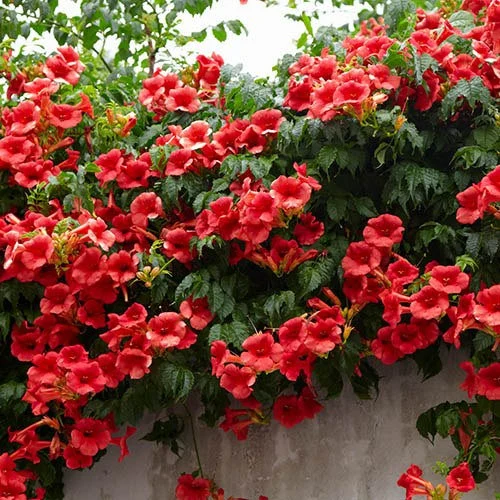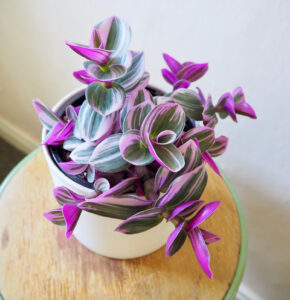The Red Trumpet Vine (Campsis radicans), also known as Trumpet Creeper or Hummingbird Vine, is a vigorous, fast-growing, and spectacular flowering plant known for its large, trumpet-shaped red to orange flowers. This deciduous vine is native to the eastern United States and is commonly used in gardens to add vibrant color, attract pollinators, and cover structures like fences, trellises, and arbors.
1. Overview of Red Trumpet Vine
The Red Trumpet Vine is a woody perennial that can grow to a height of 30-40 feet (9-12 meters) when supported by a trellis, fence, or arbor. The plant gets its name from the large, trumpet-shaped flowers that bloom in late spring to summer, often attracting hummingbirds and bees. The flowers are usually a striking red or orange, though some cultivars may have a more yellowish or orange hue.
The vine has dark green, pinnately compound leaves and can produce a dense growth, making it an excellent choice for creating privacy screens or adding a natural backdrop in a garden. Due to its aggressive growth habit, Red Trumpet Vine can quickly cover a large area, which can be both an advantage and a challenge.
2. Planting and Location
Red Trumpet Vine is best planted in full sun to ensure optimal flowering, though it can tolerate partial shade. It thrives in well-draining, fertile soil, but is adaptable to a range of soil types, including clay, sandy, and loamy soils.
a. Choosing the Right Location
- Sunlight: Full sun (at least 6 hours of direct sunlight per day) is ideal for producing the best blooms. In partial shade, the plant may not flower as profusely.
- Space Considerations: Red Trumpet Vine can spread aggressively, so make sure to plant it in a location where its rapid growth won’t become a problem. Consider planting it near a sturdy trellis, fence, or wall where it can be encouraged to climb.
- Air Circulation: Because this vine is susceptible to fungal diseases like mildew, good air circulation around the plant is important to keep it healthy. Avoid planting it in overly crowded spaces.
b. Soil Requirements
- Soil Type: Red Trumpet Vine prefers slightly acidic to neutral soil (pH 6.0-7.0), though it is adaptable to various soil types.
- Drainage: Ensure the soil has good drainage, as this plant does not like sitting in waterlogged soil. If your soil tends to retain moisture, consider improving drainage with organic matter or planting in raised beds.
c. Planting Process
- Dig a Hole: Dig a hole that is twice as wide and deep as the root ball of the vine.
- Place the Plant: Gently place the vine in the hole, ensuring the top of the root ball is level with the surrounding soil.
- Backfill and Water: Fill the hole with soil, firming it gently around the root ball. Water thoroughly to settle the soil and remove air pockets.
3. Caring for Red Trumpet Vine
Red Trumpet Vine is relatively low-maintenance once established, but it does require proper care during its growth stages.
a. Watering
- Newly Planted Vines: Water the plant regularly after planting to help it establish a strong root system. Water deeply to encourage roots to grow down into the soil.
- Established Vines: Once established, Red Trumpet Vine is fairly drought-tolerant and typically requires less frequent watering. Water during dry spells, but be cautious of overwatering, as it may cause root rot.
- Watering Tips: Always ensure that the plant’s roots are not sitting in standing water. A well-draining soil mix is essential to avoid soggy roots.
b. Fertilizing
- Balanced Fertilizer: Red Trumpet Vine is a vigorous grower, and although it doesn’t require heavy fertilization, feeding it in early spring with a balanced fertilizer can support healthy growth and blooming.
- Slow-Release Fertilizer: You can also use a slow-release fertilizer to maintain steady feeding throughout the growing season. Avoid high-nitrogen fertilizers, as these may promote excessive leafy growth at the expense of flowers.
c. Pruning and Training
Pruning is an essential aspect of maintaining the health and appearance of the Red Trumpet Vine.
- Pruning for Shape: Red Trumpet Vine benefits from annual pruning to maintain a manageable size and shape. Prune the vine back after the flowering season, removing any dead, damaged, or overly long stems.
- Training the Vine: As a climbing vine, it needs support. Train the vine to climb a trellis, arbor, or fence by tying the stems to the support structure with garden twine or plant ties. This will help direct its growth in a controlled manner.
d. Mulching
Mulching around the base of the plant helps retain moisture, suppress weeds, and regulate soil temperature. Apply a 2-3 inch layer of mulch, but avoid letting it touch the stems directly to prevent rot.
4. Pests and Diseases
While Red Trumpet Vine is generally resilient, it can still be affected by a few pests and diseases. Understanding how to deal with them will help maintain the health of your vine.
a. Common Pests
- Aphids: These small insects feed on the sap of the vine, causing leaves to curl and distort. Insecticidal soap or neem oil can be used to control aphids.
- Caterpillars: Caterpillars, especially the larvae of moths, may feed on the leaves. Hand-picking the caterpillars or using organic pesticides can help control the infestation.
- Japanese Beetles: These beetles are known to chew on the leaves and flowers. You can hand-pick them off the plant or use beetle traps.
b. Common Diseases
- Powdery Mildew: This fungal disease can cause a white, powdery coating on the leaves. To prevent powdery mildew, ensure the plant has good air circulation and avoid overhead watering.
- Root Rot: Red Trumpet Vine is susceptible to root rot in overly wet soil. Avoid overwatering and make sure the plant is in well-draining soil to prevent this issue.
- Leaf Spot Disease: Fungal leaf spot diseases can cause discolored spots on the leaves. Remove affected leaves and improve air circulation to prevent the spread of the disease.
5. Propagation
Red Trumpet Vine can be propagated through seed, cuttings, or by layering.
a. Seed Propagation
- Start Indoors: Plant seeds indoors about 8-10 weeks before the last frost. They need light to germinate, so press them gently into the soil surface. Keep the soil moist and warm until germination occurs.
- Direct Sowing: In warmer climates, you can sow the seeds directly outdoors once the risk of frost has passed.
b. Cuttings Propagation
- Softwood Cuttings: In early summer, take 4-6 inch cuttings from the tips of the vine. Remove the lower leaves and dip the cut end into rooting hormone. Place the cuttings in a well-draining rooting medium and keep them moist until they root.
- Hardwood Cuttings: In late fall or winter, take hardwood cuttings and allow them to root in a cold frame or greenhouse.
c. Layering
You can also propagate by layering, which involves bending a low-growing stem to the ground, burying part of it in soil, and allowing it to form roots before cutting it from the parent plant.
6. Uses of Red Trumpet Vine
Beyond its aesthetic beauty, the Red Trumpet Vine serves a variety of purposes in the garden.
- Attracts Pollinators: The large, tubular flowers of the Red Trumpet Vine are highly attractive to hummingbirds, bees, and butterflies, making it a wonderful addition to a pollinator garden.
- Privacy Screen: Its fast-growing, dense nature makes it an excellent choice for creating natural privacy screens or covering unsightly structures.
- Erosion Control: The vine’s extensive root system can help prevent soil erosion in garden beds and sloped areas.
- Decorative Climber: Its bright flowers and vigorous growth make it ideal for use in vertical gardens, trellises, and arbors, adding a touch of vibrancy and drama to your garden.
7. Conclusion
The Red Trumpet Vine (Campsis radicans) is an incredibly vibrant and adaptable plant that adds beauty and color to your garden. With its trumpet-shaped flowers that attract pollinators and its rapid growth, it is perfect for covering walls, fences, and trellises. Although it requires some care to control its vigorous growth and prevent diseases, it is generally a low-maintenance plant that thrives in full sun and well-draining soil. With proper care, the Red Trumpet Vine will flourish and provide years of enjoyment with its stunning blooms and ability to transform your outdoor space.


